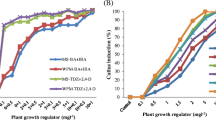Abstract
Thamnocalamus falconeri, Hook.f. ex Munro., an important bamboo species belonging to the family Poaceae, locally known as Ringal, occurs in the hills of Uttarakhand, India. This species has been traditionally exploited by local communities to support their livelihoods. Increasing needs of the hill villages impose unsustainable pressure on natural stands of Ringal in the Uttarakhand hills and forests have been degraded. The long history of excessive cutting of Ringal from natural forests and the lack of replanting threaten villager livelihoods. Replanting is required to conserve the species. We propose a protocol for generation of planting material through axillary bud proliferation for multiplication and conservation of this species. We collected offsets/rhizomes from a natural stand of T. falconeri in the Chopta Mandal areas (Chamoli district, India). These were planted at sites of varied elevation and fresh single nodal segments were collected from them as explants. Different sterilization treatments were assessed to combat contamination. Among these, treatment of 0.1 % HgCl2 followed by 5 % NaOCl, proved best. Among two cytokinin treatments, viz. BAP and Kinetin, singly or in combination, BAP alone (5 mg L−1) proved superior and resulted in 100 % bud break. BAP-supplemented MS media yielded maximum vigorous shoot formation (90 %) and maximum number of shoots (8.9). Subculturing of shoots on the same medium with similar BAP treatment (5 mg L−1 BAP) enabled continuous production of healthy shoots at similar frequency. Maximum rooting (100 %) was recorded on half-strength MS medium supplemented with 5 mg L−1 IBA. Micropropagated plants were hardened and acclimatized in soil mixture (2:1:1) and then transplanted to field sites (Magra, Uttarakhand, 1,834 m). Eight to ten months after field transplantation we recorded 100 % survival of transplanted material. This micropropagation protocol could be used successfully for raising a stock of genetically homogenous plant material in bulk for field plantations and for conservation of the species.

Similar content being viewed by others
References
Ansari SA, Kumar S, Palanisamy K (1996) Peroxidase activity in relation to in vitro rhizogenesis and precocious flowering in Bambusa arundinacea. Curr Sci 71:358–359
Arya ID, Arya S (1997) In vitro culture and establishment of exotic bamboo Dendrocalamus asper. Indian J Exp Biol 35:1252–1255
Arya S, Sharma S (1998) Micropropagation technology of Bambusa bambos through shoot proliferation. Indian For 124:725–731
Bag N, Chandra S, Palni LMS, Nandi SK (2000) Micro propagation of Dev-ringal [Thamnocalamus spathiflorus (Trin.) Munro]—a temperate bamboo, and comparison between in vitro propagated plants and seedlings. Plant Sci 156:125–135
Chambers SM, Heuch JHR, Pirrie A (1991) Micropropagation and in vitro flowering of bamboo Dendrocalamus hamiltonii Munro. Plant Cell Tissue Organ Cult 27:45–48
Das M, Pal A (2005) In vitro regeneration of Bambusa balcooa Roxb: factors affecting changes of morphogenetic competence in the axillary buds. Plant Cell Tissue Organ Cult 81:109–112
Das P, Rout GR (1991) Mass multiplication and flowering of bamboo in vitro. Orissa J Hortic 19:118–121
Debergh P (1983) Effects of agar brand and concentration on the tissue culture medium. Physiol Plant 59:270–276
Huang LC, Huang BL (1995) Loss of the species distinguishing trait among regenerated Bambusa ventricosa. Plant Cell Tissue Organ Cult 42:109–111
Huang LC, Huang BL, Chert WL (1989) Tissue culture investigations of bamboo- IV Organogenesis leading to adventitious shoots and plants in excised shoot apices. Environ Exp Bot 29:307–315
Janzen DH (1976) Why bamboos wait so long to flower. Annu Rev Ecol Syst 7:347–391
Mehta U, Rao IVR, Ram HY. 1982. In Proceedings of the fifth international congress on plant tissue culture (ed. Fujiwara A.), Tokyo, pp 109–110
Nadgauda RS, Parsharami VA, Mascarenhas AF (1990) Precocious flowering and seedling behaviour in tissue cultured bamboos. Nature 344:335–336
Nadgir AL, Phadke CH, Gupta PK, Parasharmi VA, Nair S, Mascarenhas AF (1984) Rapid multiplication of bamboo by tissue culture. Silvae Genet 33:219–233
Naithani HB, Pal M, Lepcha STS (2003) Gregarious flowering of Thamnocalamus spathiflorus and T. falconeri, bamboos fromUttaranchal India. Indian For 129:517–526
Prutpongse P, Gavinlertvatana P (1992) In vitro micropropagation of 54 species from 15 Genera of Bamboo. Hortic Sci 27:453–454
Rao IU, Rao VR, Narang V (1985) Somatic embryogenesis and regeneration of plants in the plants in Dendrocalamus strictus. Plant Cell Rep 4:191–194
Shirin F, Rana PK (2007) In vitro plantlet regeneration from nodal explants of field-grown culms in Bambusa glaucescens Willd. Plant Biotechnol Rep 1:141–147
Thomas TH, Blakesley D (1987) Practical and potential uses of cytokinins in agriculture and horticulture. Br Plant Growth Regul Group Monogr 14:69–83
Torrey JG (1976) Root hormones and plant growth. Annu Rev Plant Physiol 27:435–459
Yasodha R, Sumathi R, Malliga P, Gurumurthi G (1997) Genetic enhancement and mass production of quality propagules of Bambusa nutans and Dendrocalamus membranaceus. Indian For 4:303–306
Yeh ML, Chang WC (1986) Plant regeneration through somatic embryogenesis in callus cultures of green bamboo (Bambusa oldahamii Munro). Theor Appl Genet 73:161–163
Zaerr JB, Mapes MO (1982) Action of growth regulators. In: Bonga JM, Durzan D (eds) Tissue Culture in Forestry. Martinus Nijhoff/Dr W. Jun, The Hague, pp 231–255
Zhou B, Fu M, Xie J, Yang X, Li Z (2005) Ecological functions of bamboo forest: research and Application. J For Res 16:143–147
Acknowledgments
Our profound thanks to Forest Research Institute (FRI), Dehradun, India for providing the facilities. Authors are also thankful to the staff of Plant Physiology Discipline, FRI, Dehradun for providing necessary assistance.
Author information
Authors and Affiliations
Corresponding author
Additional information
Corresponding editor: Zhu Hong
The online version is available at http:// www.springerlink.com
Rights and permissions
About this article
Cite this article
Bakshi, M., Tiwari, C. & Razvi, S. Conservation of an important montane bamboo Thamnocalamus falconeri, Hook.f. ex Munro through axillary bud proliferation. J. For. Res. 26, 179–185 (2015). https://doi.org/10.1007/s11676-015-0022-3
Received:
Accepted:
Published:
Issue Date:
DOI: https://doi.org/10.1007/s11676-015-0022-3




